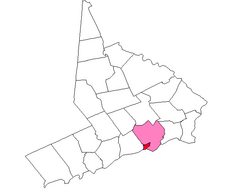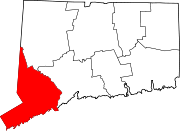Speranza

A view of Southport Harbour from neighbouring Sasco Hill.
| |
 Southport (red), shown within the town of Fairfield (pink), and Fairfield County (white), Connecticut, Long Island Sound, New England. | |
| Town | Fairfield |
| County | Fairfield |
| State | Connecticut |
| Settled | 1639 |
| Incorporated (borough) | 1831 |
| Disincorporated | 1854 |
| Population (2010) | |
| • Total | 1,585.[1] |
| Zip code | 06890 |
| Area code | 203 |
Southport is a former borough in the town of Fairfield, Connecticut, and also a census-designated place. It is located along the Long Island Sound between Mill River and Sasco Brook, where it borders Westport.
As of the 2010 census, it had a population of 1,585.
Settled in 1639, Southport has been designated a local historic district since 1967, and was listed on the National Register of Historic Places in 1971 as the Southport Historic District.
The earliest recorded event in Southport's history was the great swamp fight" or Fairfield swamp fight of July 1637 (not to be confused with the later great swamp fight of King Philip's War), an episode of the Pequot War in which colonial forces led by John Mason and Roger Ludlow vanquished a band of about 80 to 100 Pequot Indians who had earlier fled from their home territory in the Mystic area and had taken refuge with about 200 Sasqua Indians who inhabited the area that is now Fairfield.
The exact location of the battle is not known, but it is known to have been in the vicinity of Southport.
In the eighteenth century, Mill River village, a part of Fairfield, was a small hamlet of a few houses and a wharf at the mouth of Fairfield's Mill River.
Farm products from the surrounding area were shipped from Mill River's small harbour to ports in New York and beyond.
Farm products from the surrounding area were shipped from Mill River's small harbour to ports in New York and beyond.
By 1831 the village had changed its name to "South Port" and was a bustling commercial area with warehouses, churches, schools, stores and elegant houses.
Before 1853, Southport had its own local government as a borough within the town of Fairfield.
Southport became a leading coastal port on Long Island Sound, its ships carrying produce and goods back and forth to New York City.
A measure of Southport's success is the fact that throughout the 1800s it possessed the only two banks in town.
However, competition from steam boats and the rail road took its toll on prosperity.
Resourceful shippers teamed with local farmers and businessmen to keep the port going.
The Southport onion, a high quality onion, was developed and grown on Fairfield's hills and shipped in South Port market boats, keeping the harbour profitable until the end of the century.
In the 1890s, 100,000 barrels of locally grown onions, carrots, potatoes, and other goods were shipped annually from South Port harbour.
Before 1853, Southport had its own local government as a borough within the town of Fairfield.
Southport became a leading coastal port on Long Island Sound, its ships carrying produce and goods back and forth to New York City.
A measure of Southport's success is the fact that throughout the 1800s it possessed the only two banks in town.
However, competition from steam boats and the rail road took its toll on prosperity.
Resourceful shippers teamed with local farmers and businessmen to keep the port going.
The Southport onion, a high quality onion, was developed and grown on Fairfield's hills and shipped in South Port market boats, keeping the harbour profitable until the end of the century.
In the 1890s, 100,000 barrels of locally grown onions, carrots, potatoes, and other goods were shipped annually from South Port harbour.
Today, much of the old village area is part of a town historic district, first established in 1967, where buildings from three centuries are protected for future generations.
The boundaries of the town historic district are:
-- the rail road on the north.
-- the Mill River and Southport Harbour on the south
-- Church Street and Old South Road on the west
-- Rose Hill Road on the east
including all properties on both sides of these three roads.
Strict historic zoning regulations apply in the district and have been upheld by the Connecticut Supreme Court.
The South Port Historic District is also listed on the National Register of Historic Places.
The boundaries of the town historic district are:
-- the rail road on the north.
-- the Mill River and Southport Harbour on the south
-- Church Street and Old South Road on the west
-- Rose Hill Road on the east
including all properties on both sides of these three roads.
Strict historic zoning regulations apply in the district and have been upheld by the Connecticut Supreme Court.
The South Port Historic District is also listed on the National Register of Historic Places.
The main village of South Port corresponds to census tract 606.
The racial makeup of the town is 95.6% White, 2.3% Asian, 0.6% African American, 0.1% Native American, 0.1% Pacific Islander, 0.5% from other races, and 0.7% from two or more races. 1.6% of the population are Hispanic or Latino of any race.
There are 998 households out of which 22.7% have children under the age of 18 living with them, 50.1% are married couples living together, 8.3% have a female householder with no husband present, and 39.3% are non-families. 33.1% of all households are made up of individuals and 15.8% have someone living alone who is 65 years of age or older.
The average household size is 2.21 and the average family size is 2.81.
The average household size is 2.21 and the average family size is 2.81.
The median income for a household in the village is $140,307, and the median income for a family is $183,023.
Males have a median income of $131,695 versus $55,475 for females.
The per capita income for the village is $66,432. 2.0% of the population and 1.1% of families are below the poverty line.
Out of the total population, 1.5% of those under the age of 18 and 2.7% of those 65 and older are living below the poverty line.
Males have a median income of $131,695 versus $55,475 for females.
The per capita income for the village is $66,432. 2.0% of the population and 1.1% of families are below the poverty line.
Out of the total population, 1.5% of those under the age of 18 and 2.7% of those 65 and older are living below the poverty line.
South Port has had its own firefighting service since 1895.
The South Port Fire Department was organised that year as a volunteer fire department after a large arson fire in the village.
However, it is also protected by Fairfield Fire Department's Engine 4, out of the South Port Firehouse.
The South Port library is reputed to have a large collection of old and rare books.
The South Port library's annual summer book sale featured more than 140,000 volumes on sale in 2007.
The neighborhood's ZIP code is 06890, whose scope extends further north from the historic village area to include the Mill Hill area.
Eagle Hill School-Southport, a private day school for children with learning disabilities, has been located since 1985 in the former Pequot School in Southport.
The historic school building was earlier acquired by the South Port Conservancy to save it from demolition.
The historic school building was earlier acquired by the South Port Conservancy to save it from demolition.
Southport is served by the Fairfield Public Schools.
Southport is home to Mill Hill Elementary School, although children in some areas considered part of the South Port neighborhood but outside the census tract attend Timothy Dwight Elementary School.
Both Mill Hill and Dwight Schools feed into Roger Ludlowe Middle School, Tomlinson Middle School and Fairfield Ludlowe High School.[13]
Southport is home to Mill Hill Elementary School, although children in some areas considered part of the South Port neighborhood but outside the census tract attend Timothy Dwight Elementary School.
Both Mill Hill and Dwight Schools feed into Roger Ludlowe Middle School, Tomlinson Middle School and Fairfield Ludlowe High School.[13]
The main arterial road in the area, the Boston Post Road runs through South Port, connecting it to other towns along the Connecticut coast.
Interstate 95 also passes through South Port, with two exits located in the neighbourhood.
Southport is also served by the New Haven Line of the Metro-North Commuter Railroad at South Port Railroad Station, with frequent trains to New Haven and New York City.
Limited bus service is provided by the Greater Bridgeport Transit Authority.
Interstate 95 also passes through South Port, with two exits located in the neighbourhood.
Southport is also served by the New Haven Line of the Metro-North Commuter Railroad at South Port Railroad Station, with frequent trains to New Haven and New York City.
Limited bus service is provided by the Greater Bridgeport Transit Authority.
The following are among the notable people who have lived in Southport:
James Truslow Adams, historian and writer
Anatole Broyard, author.
Samuel J. Palmisano, former chief executive officer of IBM
Jason Robards, actor, producer and director.Don Imus, Radio Personality
Jack Welch, former CEO General Electric
Ina Garten,Celebrity Cook and author
Jeffrey Garten,Economic Adviser and author
Movies filmed in Southport include:
- Revolutionary Road (2007)
- And So It Goes (2014)
References:
- Race, Hispanic or Latino, Age, and Housing Occupancy: 2010 Census Redistricting Data (Public Law 94-171) Summary File (QT-PL), Southport CDP, Connecticut". U.S. Census Bureau, American FactFinder 2. Retrieved August 11, 2011.
- http://www.fairfieldhs.org/explore-fairfield-history.php#great
- History of the Town of Fairfield, Connecticut
- Charles, Eleanor. "If You're Thinking of Living in; Southport", New York Times, December 22, 1985.
- Gibbons v. Fairfield Historic District Commission, 285 Conn. 755; 941 A.2d 917; 2008 Conn. LEXIS 80
- An Enclave for One’s Inner Scarlett, New York Times, June 12, 2009
- "American FactFinder". United States Census Bureau. Retrieved 2008-01-31.
- Abbreviated History of The Southport Fire Department, Southport Fire Department Corp. website, accessed June 17, 2009
- Economic Development & Affordable Housing, Congressman Jim Himes' website, accessed July 13, 2009
- Calendar section of The Norwalk Citizen-News, July 27, 2007, p. A35
- History, Eagle Hill-Southport website, accessed October 13, 2009
- Southport Conservancy website, accessed October 13, 2009
- Fairfield Public Schools website, accessed September 1, 2010
- Governor Rell Announces Plan to Rebuild Southport Train Station; Demolition Unnecessary; Building Can Be Salvaged, Connecticut Department of Transportation press release, 2/20/2008
- The Southport Conservancy (organization for preservation and restoration of historic properties in Southport)
- The Southport Globe (a website focused on the community)
- The Southport Picture File (a collection of 800 historical photos compiled by historian V. Louise Higgins. Housed at Pequot Library and accessible online.)
- Living in Southport, Conn. (New York Times photo collection)
- Brilvitch, Charles. 1977. Walking Through History. The Seaports of Black Rock and Southport. Fairfield Historical Society.
| ||||||||||||||||||||










No comments:
Post a Comment